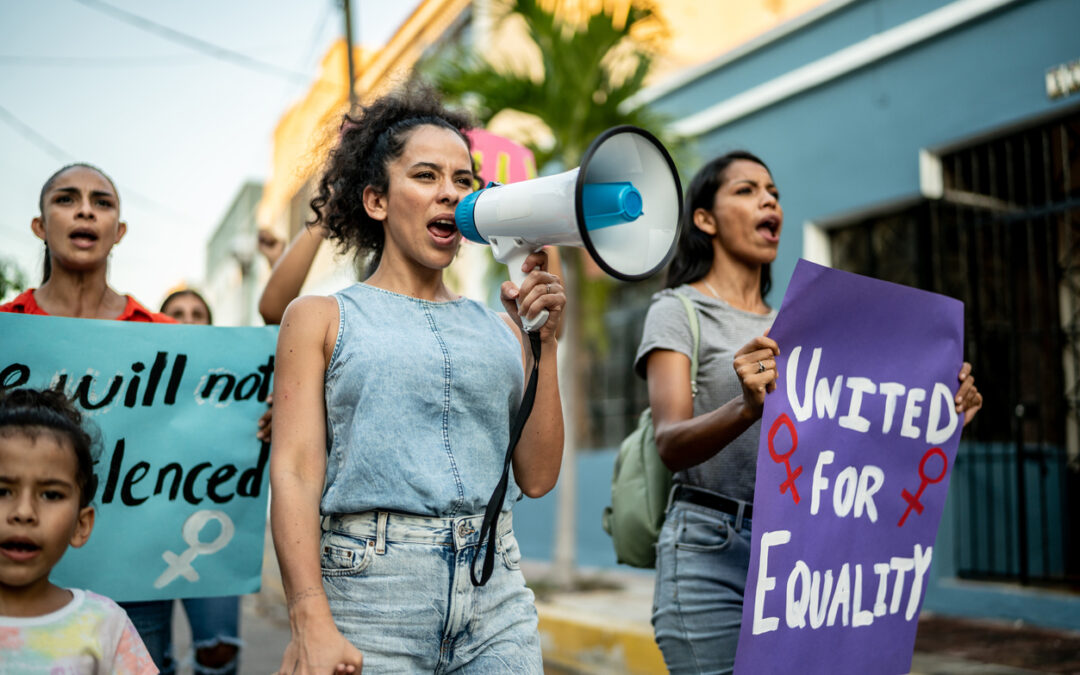
The Lives of Women Advanced Substantially After Roe v. Wade Was Passed
Let’s go back to 1970, three years before the Roe v. Wade decision. The average age for women at first marriage was just under 21 in the U.S.

Let’s go back to 1970, three years before the Roe v. Wade decision. The average age for women at first marriage was just under 21 in the U.S. Twenty-five percent of high school graduates who were women aged 18 to 24 were enrolled in college and only about 8 percent of adult women had completed four years of college. In those years childbearing was still closely tied to marriage. Women who conceived before marriage were likely to marry before the birth occurred.
Childbearing was still closely tied to marriage then. Those who conceived before marriage were likely to marry before the birth occurred. It wasn’t yet common for married women with young children under age 6 to be employed; only about 37 percent were in the labor force.
By 1980, the average age at marriage had increased to 22. Women who graduated from high school were enrolling in college at a higher rate. At this same time thirty percent of American women aged 18 to 24 who had graduated from high school were enrolled in college, and 13.6 percent had completed a four-year college degree. Forty-five percent of married mothers with young children were in the labor force.
Today, roughly two generations after Roe v. Wade, women are postponing marriage, marrying for the first time at about age 27 on average. Moreover, the majority of college students are now women, and participation in the paid labor force has become a common factor in many women’s lives.
While these changes may not be directly attributable to Roe v. Wade, they occurred shortly after its passage – and they’ve continued unabated since then.
The right to make this personal health care decision has allowed women to pursue educational and employment opportunities that were often unthinkable prior to Roe v. Wade. The Supreme Court noted in 1992 that “the ability of women to participate equally in the economic and social life of the Nation has been facilitated by their ability to control their reproductive lives” Justice Harry Blackmun, the author of Roe, called the decision “a step that had to be taken as we go down the road toward the full emancipation of women”
Women’s Rights After Roe v. Wade Was Passed: A Timeline
1973: ROE V WADE CASE IS DECIDED
In its landmark 7-2 Roe v. Wade decision, the U.S. Supreme Court ruled that the Constitution protects an American woman’s right to a safe and legal abortion.
1974: WOMEN CAN NOW GET A CREDIT CARD IN THEIR OWN NAME
Banks could refuse women a credit card until the Equal Credit Opportunity Act of 1974 was signed into law. Prior to that, a bank could refuse to issue a credit card to an unmarried woman, and if a woman was married, her husband was required to cosign. Many banks required single, divorced or widowed women to bring a man with them to cosign for a credit card, and some discounted the wages of women by as much as 50% when calculating their credit card limits. Despite that 1974 law, a 2012 study by the Financial Industry Regulatory Authority, found that women pay about half a percentage point more in credit card interest rates than men, regardless of financial literacy level and after accounting for other demographic characteristics like income and education.
1975: WOMEN ARE NOT “TOO FRAGILE” OR “TOO SYMPATHETIC” TO SERVE ON A JURY
The Civil Rights Act of 1957 gave women the right to serve on federal juries, however it was not until 1975 that all 50 states passed similar legislation. It varied by state (Utah deemed women fit for jury duty way back in 1898), but the main reason women were kept out of jury pools was that they were considered the center of the home, which was their primary responsibility as caregivers. They were also thought to be too fragile to hear the grisly details of crimes and too sympathetic by nature to be able to remain objective about those accused of offenses. In 1961, the Supreme Court unanimously upheld a Florida law that exempted women from serving on juries. It wasn’t until 1975 that women could serve on juries in all 50 states. It was not until the U.S. Supreme Court’s decision in Taylor v. Louisiana when the Court held that states must treat men and women in the same way in respect to jury service in 1975.
1975: WOMEN WHO GET PREGNANT WILL NO LONGER BE INVOLUNTARILY DISCHARGED
Between 1975 and 1979, many Army rules and regulations concerning women changed and the standards for men and women in the Army began to equalize. The defense secretary directed the elimination of involuntary discharge of military women because of pregnancy and parenthood, June 30, 1975. Mandatory defensive weapons training was initiated for enlisted women, and they were authorized to serve the same length of overseas tours as men – increased from 24 months to 36 months for single females. Effective April 1, 1976, the minimum age of enlistment of women was reduced to the same as for men, and by October 1979, all enlistment qualifications became the same for men and women.
1976: WOMEN CAN BE ADMITTED INTO MILITARY ACADEMIES
Well into the 1970’s, women were only allowed in the military as nurses or support staff. By 1977, combined basic training for men and women became policy and the need for a separate Women’s Army Corps faded. In October of 1975 President Gerald Ford signed Public Law 94-106 that permitted women to be admitted to all service academies beginning in 1976. In 1980, the first women cadets graduated from U.S. Military Academy, West Point, New York. Since then, women have continued to enter every class there.
1977: WOMEN CAN TAKE LEGAL ACTION FOR WORKPLACE SEXUAL HARASSMENT|
A 1974 case, Barnes v. Train, is commonly thought of as the first sexual harassment case. It was not until 1977 when the U.S. Court of Appeals found that the woman, Paulette Barnes, had been mistreated and that a supervisor had sexually harassed her. The Civil Rights Act of 1964 created the basis for discrimination cases in its Article VII and established the Equal Employment Opportunity Commission. But it wasn’t until 1980 that the EEOC officially established guidelines for sexual harassment in the workplace and stated that sexual harassment is a type of sex discrimination that is prohibited by the Civil Rights Act of 1964.
To provide more protection for employees being discriminated against in the workplace, Congress then passed the Civil Rights Act of 1991, which is signed into law by President George H.W. Bush. This Act gave plaintiffs the right to a jury trial in federal court but also the right to collect compensatory and punitive damages from their employers.
1978: WOMAN ARE GUARANTEED THAT THEY WILL NOT BE FIRED FOR GETTING PREGNANT
Women didn’t get this protection until 1978. The Pregnancy Discrimination Act of 1978 prohibited sexual discrimination on the basis of pregnancy, childbirth, or related medical conditions. In 1978 the US Congress passed the Pregnancy Discrimination Act as an amendment to the sex discrimination section of the Civil Rights Act of 1964.
1993: WOMEN WHO ARE RAPED BY THEIR HUSBANDS NOW HAVE A LEGAL STANDING
In 1986 the Federal Sexual Abuse Act criminalized marital rape on all Federal lands. However, it wasn’t until 1993 that marital rape became a crime in at least 1 section of the sexual offense codes in all 50 States. By 1996, 16 States had completely repealed their marital rape exemptions, and 33 States had partially repealed their exemptions. Although legal reforms have helped victims define and report their experiences as well as seek legal recourse, marital rape is still not legally handled as though it is as serious as other forms of rape.
2016: WOMEN CAN GO TO COMBAT ON THE FRONT LINES
Women were admitted into military academies in 1976, but it was not until 2013 that the military ban on women in combat was lifted. On January 24, 2013, then-Secretary of Defense Leon Panetta rescinded the rule that restricted women from serving in combat units and directed the military departments and services to review their occupational standards and assignment policies and to make recommendations for opening all combat roles to women no later than January 1, 2016. On December 3, 2015, Secretary of Defense Ashton Carter ordered the military to open all combat jobs to women with no exceptions.
Roe v. Wade Was Just Overturned. What Does That Mean For Women?
The Supreme Court overturned Roe v. Wade on Friday, a decision that the majority of Americans did not want, which effectively will reduce women’s control over their reproductive lives. Without the landmark precedent in place, the national abortion landscape will change quickly. The state antiabortion laws slated to take effect — the “trigger bans” — all work a little differently. Some will activate within minutes when the designated state official certifies the court’s decision, while others will go into effect 30 days after the decision is announced. While all of these laws make exceptions for the life of the mother, most do not include exceptions for rape and incest.
Access to abortion is a key component of women’s comprehensive health care. The ability to choose if, when, and how to give birth is linked to women’s economic success, educational attainment, and general health and well-being. We can see the devastating effect that teen pregnancy, for example, has on a woman’s education. Thirty percent of all teenage girls who drop out of school cite pregnancy and parenthood as key reasons. Only 40 percent of teen mothers finish high school. Fewer than 2 percent finish college by age 30. Two-thirds of families started by teens are poor, and nearly 1 in 4 will depend on welfare within three years of a child’s birth. Many children will not escape this cycle of poverty. Only about two-thirds of children born to teen mothers earn a high school diploma, compared to 81 percent of their peers with older parents.
Overturning Roe v. Wade doesn’t really end abortions; it ends safe abortions. Abortion has been proven to be one of the safest medical procedures, but now some women will have to take extreme risks to terminate the pregnancy. This is not just a healthcare crisis for women, but our daughters now have less rights than their mothers had. Women could be forced into obligatory pregnancies once again and denied the opportunity to make life plans that prioritizes educational and employment pursuits.

Do I Need to Give Consent to Be Photographed?
Have you ever had someone take your photograph and you didn’t want them to? Were they in the wrong? Short answer: it depends. It all starts with the First Amendment and Freedom of the Press, but hold on, I’m still talking about personal photos here. Let’s dive in to how we arrive at when it’s legal to photograph other people without their consent.

Foreign Aid: The Misunderstood Perception of America’s International Contribution
Foreign Aid: The Misunderstood Perception of America’s Contribution Seventy-five years of American foreign aid has produced more fiction than fact when it comes to how U.S. tax dollars are spent.IMAGE: Rollingstone.com, Michele Eve Sandberg/ShutterstockJulianna...

Myth: Growth from Tax Cuts Makes Up Lost Revenue
It’s a common myth that reducing marginal tax rates would spur economic growth. The idea is that lower tax rates will give people more after-tax income that they will spend on goods and services. Is this myth true or false?

Defunding the Police Does Not Mean There Won’t Be Any Police.
As protests over police brutality and systemic racism continue in the wake of George Floyd’s death, there have been growing calls to defund the police. But what exactly does that mean?

